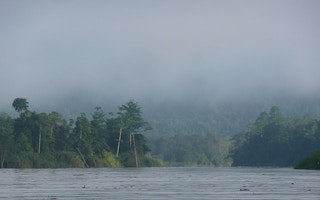Thanks to human actions, carbon dioxide levels in the atmosphere are soaring. But plants are thankfully removing some of that greenhouse gas. In fact, the amount of atmospheric carbon that plants absorb using photosynthesis to make organic matter has increased in nearly constant proportion to the rise in atmospheric carbon dioxide levels, a new study has found. But there’s only so much plants can do.
“We’re lucky that plants are responding in this way and soaking up some of our emissions,” Lucas Cernusak, lead author of the study and an associate professor at James Cook University in Australia, told Mongabay. “We should take advantage of that and get to work to try reduce emissions and reduce the amount of CO2 being produced by our energy production.”
For his calculations, Cernusak relied on data from a 2017 study led J. Elliott Campbell, an associate professor at the University of California, Santa Cruz. Campbell and his colleagues had then showed that photosynthesis had increased 31 per cent compared to what it was before the industrial revolution.
Since direct measurement of carbon dioxide uptake for photosynthesis is complicated — plants take in carbon dioxide to make sugars, but also release the gas during respiration — the researchers used a proxy, carbonyl sulfide, that’s relatively simpler to track. Made of a carbon atom, an oxygen atom and a sulfur atom, carbonyl sulfide occurs in much lower concentrations in the atmosphere, and has a one-way movement into the plants. This makes it a good tracer for photosynthesis, some researchers say.
“
The increased photosynthesis removes CO2 from the air, but simply can’t keep up with the rapid increases in global fossil fuel emissions.
J. Elliott Campbell, associate professor, University of California
“It diffuses into leaves when stomata open for photosynthesis and when it enters the leaf, there’s an enzyme called carbonic anhydrase which effectively destroys the carbonyl sulfide. So it just has a one-way flux that is analogous to photosynthesis,” Cernusak said.
To see the historical change in carbon dioxide taken in by plants for photosynthesis, Campbell and his team had measured carbonyl sulfide in Antarctica’s ice cores; the ice there contains trapped air bubbles that serve as historic records of the Earth’s atmosphere. In the latest study, Cernusak and his colleagues used computer models to further analyze those measurements.
The models showed that global photosynthesis in terrestrial plants has been keeping pace with the increase in greenhouse gas levels — for now. “It’s clear that computer models in this study are consistent with increasingly faster rates of photosynthesis,” Campbell, who was not involved in the latest study, told Mongabay.
The models also pointed to what is likely driving the increase in photosynthesis. Elevated carbon dioxide levels, the authors found, are like fertilizer for plants in the tropics, driving an increase in their leaf area. In higher latitudes, though, it is rising global temperatures that appear to be increasing both leaf area and growing seasons among plants.
“The big question is how much longer will this last,” Campbell said, referring to the increasing rates of photosynthesis.
The researchers agree that this remains an outstanding question. The increase in photosynthesis rates will likely “slow owing to saturating photosynthesis, nutrient limitations, or leaf area reaching a maximum per unit ground area,” they write in the paper.
What also remains unknown is the amount of carbon that gets permanently locked out of the atmosphere. Plants use carbon dioxide to make sugars, then use energy stored in those sugars to build their tissues and grow. Some of the carbon dioxide gets released back into the atmosphere via processes like respiration.
“It could be the case that plants have more sugars, more carbohydrates from doing photosynthesis, but they might use that for other processes besides plant growth,” Cernusak said. “There’s some efflux, there’s some exudation into the soil to improve nutrient foraging or they might allocate it to fine roots or mycorrhizal fungi. That’s what we’ve outlined as an outstanding question.”
If the gross primary production (GPP), defined as the total amount of carbon captured by photosynthesis, continues to increase while the net primary production (or net increase in plant biomass, calculated by subtracting respiration from GPP) doesn’t increase as fast, “that would most likely diminish the land carbon sink,” Cernusak said.
For now, plants seem to be providing a helping hand by slowing down the increase in atmospheric carbon dioxide levels; but they can’t clean up our mess on their own. As science writer Carl Zimmer put it: “It’s a bit like hearing that your chemotherapy is slowing the growth of your tumor by 25 per cent.”
“The big takeaway here is that humans have overwhelmed the Earth’s capacity to stabilise its climate,” Campbell said. “The increased photosynthesis removes CO2 from the air, but simply can’t keep up with the rapid increases in global fossil fuel emissions.”
“It is also a good reason, not that we need more rationale, to protect forests so they can continue to act as carbon sinks,” Cernusak added.
This story was published with permission from Mongabay.com.










